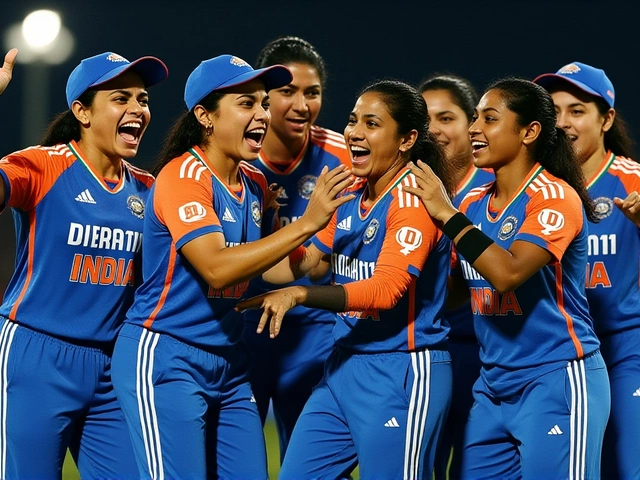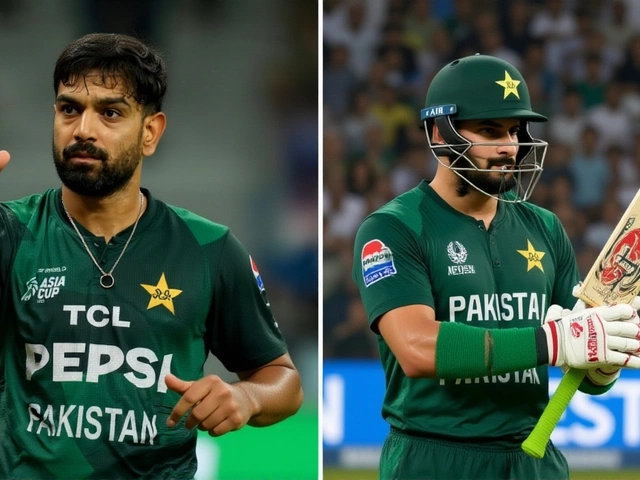Haris Rauf Banned for Asia Cup Final After ICC Sanctions Over Controversial Gestures vs India

When Haris Rauf raised his fingers in a ‘6-0’ gesture toward Indian fans during the Asia Cup 2025 Super-4 clash on September 21, he didn’t just spark outrage—he triggered a disciplinary storm that would cost him his chance at cricketing glory. The International Cricket Council announced on September 26, 2025, that Rauf, Pakistan’s fiery fast bowler, had been handed a two-match ban for conduct bringing the game into disrepute. The punishment? A 30% fine on his match fees for both the September 14 and September 28 games, plus four demerit points—enough to trigger an automatic suspension. And the timing couldn’t be worse: the ban includes the Asia Cup 2025 Dubai International Cricket Stadium final, where Pakistan was set to face India in a showdown charged with more than just cricketing pride.
The Match That Ignited the Firestorm
The India-Pakistan game on September 21 in Dubai wasn’t just another fixture. It was the first bilateral encounter between the two nations since the April 2025 terrorist attack in Pahalgam, Kashmir, that killed 26 Indian tourists. India’s subsequent military operation, dubbed ‘Operation Sindoor,’ had already elevated tensions to a boiling point. On the field, emotions ran even higher. Rauf’s ‘6-0’ gesture—mocking India’s scoreline—was captured on multiple camera angles. Then came the mimicry: arms flailing like a plane in freefall, a reference to India’s recent drone strikes on terrorist targets in Pakistan. Fans in the stands erupted. Social media exploded. And the Board of Control for Cricket in India didn’t wait. By September 24, they’d filed a formal complaint with the ICC, backed by video evidence submitted to match referee Andy Pycroft.Who Got What—and Why
The hearing, held at the Pakistan team’s hotel in Dubai on September 26, was presided over by Richie Richardson, the ICC’s elite panel referee. Rauf appeared in person, flanked by team manager Naveed Akram Cheema. His defense? ‘It was just passion.’ The ICC wasn’t buying it. Article 2.21 of the Code of Conduct was clear: conduct that brings the game into disrepute carries consequences. Rauf’s actions were deemed intentional, public, and inflammatory. Two demerit points per match? That’s two strikes on his record within 24 months. Automatic ban. Meanwhile, Sahibzada Farhan claimed his ‘gunfire’ celebration—mimicking pistol shots with his fingers—was a Pashtun tribal tradition. He insisted it had no political meaning. The ICC acknowledged cultural context but ruled it inappropriate on a global stage. He got a stern warning. No fine. No demerits. Just a verbal slap on the wrist. The inconsistency drew immediate criticism. Why was Rauf punished twice as harshly? Was it the gesture’s symbolism? The timing? Or the fact that he’s a high-profile bowler whose actions carry more weight?India’s Side of the Story
But India wasn’t off the hook. Suryakumar Yadav, India’s T20 captain, was fined 30% of his match fee and handed two demerit points for refusing to shake hands with Pakistan skipper Salman Agha during the toss. It was dubbed ‘No-handshake part 2’—a repeat of the infamous 2023 T20 World Cup moment. The Pakistan Cricket Board had lodged a formal complaint. Richardson reviewed footage and concluded Yadav’s action, while not violent, was disrespectful under the spirit of the game. The PCB had expected more. BCCI, meanwhile, called it ‘a minor breach blown out of proportion.’
Why This Matters Beyond the Field
Cricket between India and Pakistan has always been more than sport. It’s a proxy for history, politics, and trauma. Since the 1999 Kargil War, every match has carried the weight of unresolved conflict. The Pahalgam attack and Operation Sindoor turned this year’s Asia Cup into a tinderbox. The ICC’s decision—seemingly uneven, but technically consistent—reflects a deeper struggle: how to police emotion in a game where national pride is inseparable from performance. Fans in Lahore and Delhi are already debating whether Rauf was made a scapegoat. Others argue that if gestures like his go unpunished, the game becomes a platform for political theater.What’s Next? The Final Without Rauf
With Rauf banned, Pakistan’s bowling attack is left with Shaheen Afridi, Naseem Shah, and Mohammad Hasnain. Without their most aggressive strike bowler, their chances against India’s explosive top order dim. Pakistan’s coach, Misbah-ul-Haq, called the ban ‘harsh but fair’—a rare diplomatic nod. But behind closed doors, sources say the PCB is preparing an appeal. Meanwhile, India’s team, buoyed by Suryakumar’s form and the return of Jasprit Bumrah, enters the final as favorites. The final, set for September 28, will be watched by over 150 million viewers across South Asia. And for the first time in years, the scoreboard won’t be the only thing that matters.
Historical Echoes
This isn’t the first time gestures sparked controversy. In 2017, Virat Kohli was fined for pointing his bat at the crowd after a century in Australia. In 2019, Pakistan’s Shoaib Malik was warned for mimicking a ‘chicken’ celebration after dismissing an Indian batter. But none carried the political gravity of this case. The ICC has been cautious since the 2007 World Cup, when a Pakistani player’s salute to a crowd was misinterpreted as support for separatists. The lesson? In India-Pakistan cricket, every gesture is a headline.Frequently Asked Questions
Why was Haris Rauf banned but Sahibzada Farhan only warned?
Rauf’s actions—‘6-0’ and mimicking a falling aircraft—were deemed direct provocations tied to recent military actions in Kashmir, while Farhan’s ‘gunfire’ celebration, though inappropriate, was framed as a cultural expression with no overt political intent. The ICC viewed Rauf’s gestures as targeted and symbolic, whereas Farhan’s was seen as an overzealous but non-malicious celebration. Rauf also had prior demerit points, triggering the automatic ban.
How does Rauf’s ban affect Pakistan’s chances in the Asia Cup final?
Rauf was Pakistan’s most consistent death-over bowler in the tournament, taking 7 wickets in 4 matches at an economy of 7.8. His absence leaves a gap in their pace attack, especially against India’s aggressive middle order. Without him, Pakistan may rely more on spinners and risk being outgunned in the final overs. Analysts say his ban could be the decisive factor in India’s favor.
Was Suryakumar Yadav’s handshake refusal really a violation?
Yes. The ICC’s Code of Conduct requires players to show mutual respect, and refusing a handshake is explicitly listed as conduct contrary to the spirit of cricket. While not malicious, it was seen as a symbolic snub in a high-stakes match. The fine and demerit point were standard for such offenses—similar to the 2023 World Cup incident involving India’s KL Rahul and Sri Lanka’s Wanindu Hasaranga.
Could this lead to a boycott or cancellation of future India-Pakistan matches?
Unlikely. Both boards rely heavily on the revenue from these matches—over $100 million in broadcast rights alone in 2024. While political tensions are high, cricket remains a rare diplomatic channel. The ICC will likely impose stricter conduct guidelines before the next bilateral series, but canceling matches would hurt global viewership and commercial interests far more than any gesture ever could.
What’s the ICC’s track record with player conduct in India-Pakistan games?
The ICC has historically favored warnings over bans in these matches, fearing backlash from either side. Since 2000, only three players have received match bans for conduct violations in India-Pakistan games—two from Pakistan, one from India. Rauf’s ban is the first since 2017 and the harshest ever issued in a bilateral Asia Cup fixture. It signals a shift: the ICC is no longer willing to treat political tensions as an excuse for on-field provocation.
Will this affect how players celebrate in future matches?
Absolutely. Players are already being briefed by team management to avoid any gestures that could be interpreted as political or provocative. Even celebratory fist pumps are being scrutinized. The ICC is expected to release new guidelines before the next major tournament, requiring players to submit any planned celebrations for review. Cricket’s joy is being policed more tightly than ever.




